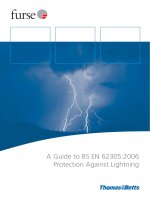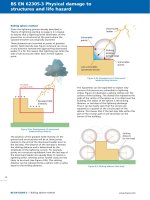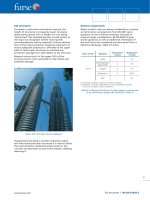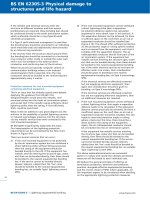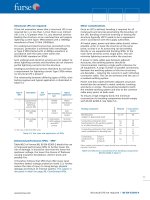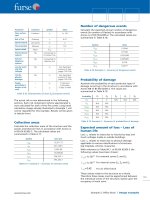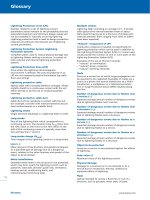Bsi bs en 02155 3 1993 (1999)
Bạn đang xem bản rút gọn của tài liệu. Xem và tải ngay bản đầy đủ của tài liệu tại đây (227 KB, 10 trang )
BRITISH STANDARD AEROSPACE SERIES
Test methods for
transparent materials
for aircraft glazing —
Part 3: Determination of refractive
index
The European Standard EN 2155-3:1993 has the status of a
British Standard
UDC 629.73.023.26:620.1:535.32
BS EN
2155-3:1993
BS EN 2155-3:1993
Cooperating organizations
The European Committee for Standardization (CEN), under whose supervision
this European Standard was prepared, comprises the national standards
organizations of the following countries:
Austria
Belgium
Denmark
Finland
France
Germany
Greece
Iceland
Ireland
Italy
Luxembourg
Netherlands
Norway
Portugal
Spain
Sweden
Switzerland
United Kingdom
This British Standard, having
been prepared under the
direction of the Aerospace
Standards Policy Committee,
was published under the
authority of the Standards
Board and comes
into effect on
15 April 1993
© BSI 11-1999
The following BSI references
relate to the work on this
standard:
Committee reference ACE/62
Draft for comment 91/74927 DC
ISBN 0 580 22064 8
Oesterreichisches Normungsinstitut
Institut belge de normalisation
Dansk Standardiseringsraad
Suomen Standardisoimisliito, r.y.
Association franỗaise de normalisation
Deutsches Institut fỹr Normung e.V.
Hellenic Organization for Standardization
Technological Institute of Iceland
National Standards Authority of Ireland
Ente Nazionale Italiano di Unificazione
Inspection du Travail et des Mines
Nederlands Normalisatie-instituut
Norges Standardiseringsforbund
Instituto Portugs da Qualidade
Asociación Espola de Normalización y Certificación
Standardiseringskommissionen i Sverige
Association suisse de normalisation
British Standards Institution
Amendments issued since publication
Amd. No.
Date
Comments
BS EN 2155-3:1993
Contents
Cooperating organizations
National foreword
Foreword
Introduction
1
Scope and field of application
2
Purpose of the method
3
Definition
4
Apparatus and material
5
Specimens
6
Conditioning
7
Procedure
8
Test report
National annex NA (informative) Committees responsible
© BSI 11-1999
Page
Inside front cover
ii
2
3
3
3
3
3
3
3
3
3
Inside back cover
i
BS EN 2155-3:1993
National foreword
This British Standard has been prepared under the direction of the Aerospace
Standards Policy Committee and is the English language version of
EN 2155-3:1991 Aerospace Series — Test methods for transparent materials for
aircraft glazing — Part 3: Determination of refractive index, published by the
European Committee for Standardization (CEN).
EN 2155-3 was produced as a result of international discussion in which the UK
took an active part.
A British Standard does not purport to include all the necessary provisions of a
contract. Users of British Standards are responsible for their correct application.
Compliance with a British Standard does not of itself confer immunity
from legal obligations.
Summary of pages
This document comprises a front cover, an inside front cover, pages i and ii,
the EN title page, pages 2 to 4, an inside back cover and a back cover.
This standard has been updated (see copyright date) and may have had
amendments incorporated. This will be indicated in the amendment table on the
inside front cover.
ii
© BSI 11-1999
EN 2155-3
EUROPEAN STANDARD
NORME EUROPÉENNE
EUROPÄISCHE NORM
January 1993
UDC 629.73.023.26:620.1:535.32
Descriptors: Aircraft industry, glazing, transparent plastics, glass, tests, determination, refractivity
English version
Aerospace series
Test methods for transparent materials for aircraft glazing
Part 3: Determination of refractive index
Série aérospatiale
Méthodes d’essais pour matériaux
transparents pour vitrages aéronautiques
Partie 3: Détermination de l’indice de réfraction
Luft- und Raumfahrt
Prüfverfahren für transparente Werkstoffe zur
Verglasung von Luftfahrzeugen
Teil 3: Bestimmung des Brechungsindexes
This European Standard was approved by CEN on 1993-01-04. CEN members
are bound to comply with the CEN/CENELEC Internal Regulations which
stipulate the conditions for giving this European Standard the status of a
national standard without any alteration.
Up-to-date lists and bibliographical references concerning such national
standards may be obtained on application to the Central Secretariat or to any
CEN member.
This European Standard exists in three official versions (English, French,
German). A version in any other language made by translation under the
responsibility of a CEN member into its own language and notified to the
Central Secretariat has the same status as the official versions.
CEN members are the national standards bodies of Austria, Belgium,
Denmark, Finland, France, Germany, Greece, Iceland, Ireland, Italy,
Luxembourg, Netherlands, Norway, Portugal, Spain, Sweden, Switzerland and
United Kingdom.
CEN
European Committee for Standardization
Comité Européen de Normalisation
Europäisches Komitee für Normung
Central Secretariat: rue de Stassart 36, B-1050 Brussels
© 1993 Copyright reserved to CEN members
Ref. No. EN 2155-3:1993 E
EN 2155-3:1993
Foreword
This European Standard has been prepared by the
European Association of Aerospace Manufacturers
(AECMA).
After inquiries and votes carried out in accordance
with the rules of this Association, this Standard has
successively received the approval of the National
Associations and the Official Services of the member
countries of AECMA, prior to its presentation to
CEN.
This European Standard shall be given the status of
a national standard, either by publication of an
identical text or by endorsement, at the latest by
July 1993, and conflicting national standards shall
be withdrawn at the latest by July 1993.
According to the CEN/CENELEC Internal
Regulations, the following countries are bound to
implement this European Standard:
Austria, Belgium, Denmark, Finland, France,
Germany, Greece, Iceland, Ireland, Italy,
Luxembourg, Netherlands, Norway, Portugal,
Spain, Sweden, Switzerland and United Kingdom.
2
© BSI 11-1999
EN 2155-3:1993
Introduction
The method described in this standard differs from
ISO 489, method A, in the testing conditions.
1 Scope and field of application
This standard specifies the method used for the
determination of the refractive index applicable for
transparent materials used in aircraft glazing.
2 Purpose of the method
This method is used for the control of purity and
composition of materials.
The refractive index shall be considered when
designing the parts.
3 Definition
The refractive index n 23 is the ratio of the velocity
D
of light in a vacuum to that in the material
measured at 23 °C for the sodium D line
wavelength 589,3 nanometres.
4 Apparatus and material
Abbe refractometer or any other refractometer
that can be shown to give the same results, the
accuracy shall be 0,001.
4.2 Source of white light.
4.1
4.3
Contacting liquid
Saturated aqueous solution of zinc chloride made
slightly acid.
5 Specimens
The test specimen cut from the sample shall be of
such a size as will fit on the face of the fixed half of
the refractometer prisms.
For the Abbe refractometer the dimensions are as
follows:
— 6 mm wide,
— 12 mm long,
— 3 mm thick.
For necessary accuracy the surface of the test
specimen in contact with the prism shall be
sufficiently flat and polished in order to obtain
satisfactory contact between the test specimen and
the prism. This contact is indicated by the dividing
line between the light and dark halves of the
eyepiece field appearing sharp and straight.
© BSI 11-1999
A second surface is prepared under the same
conditions perpendicular to the first and on one end
of the test specimen. These two surfaces shall
intersect along a sharp line without a bevelled or
rounded edge.
6 Conditioning
The specimen shall be preconditioned
at (23 ± 2) °C, (50 ± 5) % relative humidity for at
least 48 h prior to testing. Before the determination,
the apparatus shall reach the same conditions.
The test is to be performed immediately after
conditioning.
7 Procedure
The procedure for the Abbe refractometer is
described herebelow. For other refractometers the
procedure may be modified if necessary.
The determination is carried out at (23 ± 0,5) °C. A
small drop of the contacting liquid is placed on the
polished surface of the test specimen which is then
placed in firm contact with the surface of the prism
with the polished small edge of the specimen
towards the source of light. The index arm of the
refractometer is then adjusted until half of the
eyepiece field is dark. The compensator (Amici
prisms) drum is then adjusted until all colour is
removed from the field, after which the index arm is
adjusted by means of the vernier until the dividing
line between the light and dark portions of the field
coincides exactly with the point of intersection of the
eyepiece cross hairs.
The refractive index for the sodium D line is then
read on the instrument scale.
8 Test report
The test report shall include the following
information:
— reference to this standard.
— refractive index to the nearest significant
figure warranted by the precision and
repeatability of measurement (if the refractive
index is expressed to more than three significant
figures, the wavelength of light for which the
measurement was made is also reported).
— position on the original sample from which the
test specimen was cut.
3
4
blank
BS EN 2155-3:1993
National annex NA (informative)
Committees responsible
The United Kingdom participation in the preparation of this European Standard was entrusted by the
Aerospace Standards Policy Committee (ACE/-) to Technical Committee ACE/62 upon which the following
bodies were represented:
British Plastics Federation
Ministry of Defence
Society of British Aerospace Companies Limited
© BSI 11-1999
BS EN
2155-3:1993
BSI — British Standards Institution
BSI is the independent national body responsible for preparing
British Standards. It presents the UK view on standards in Europe and at the
international level. It is incorporated by Royal Charter.
Revisions
British Standards are updated by amendment or revision. Users of
British Standards should make sure that they possess the latest amendments or
editions.
It is the constant aim of BSI to improve the quality of our products and services.
We would be grateful if anyone finding an inaccuracy or ambiguity while using
this British Standard would inform the Secretary of the technical committee
responsible, the identity of which can be found on the inside front cover.
Tel: 020 8996 9000. Fax: 020 8996 7400.
BSI offers members an individual updating service called PLUS which ensures
that subscribers automatically receive the latest editions of standards.
Buying standards
Orders for all BSI, international and foreign standards publications should be
addressed to Customer Services. Tel: 020 8996 9001. Fax: 020 8996 7001.
In response to orders for international standards, it is BSI policy to supply the
BSI implementation of those that have been published as British Standards,
unless otherwise requested.
Information on standards
BSI provides a wide range of information on national, European and
international standards through its Library and its Technical Help to Exporters
Service. Various BSI electronic information services are also available which give
details on all its products and services. Contact the Information Centre.
Tel: 020 8996 7111. Fax: 020 8996 7048.
Subscribing members of BSI are kept up to date with standards developments
and receive substantial discounts on the purchase price of standards. For details
of these and other benefits contact Membership Administration.
Tel: 020 8996 7002. Fax: 020 8996 7001.
Copyright
Copyright subsists in all BSI publications. BSI also holds the copyright, in the
UK, of the publications of the international standardization bodies. Except as
permitted under the Copyright, Designs and Patents Act 1988 no extract may be
reproduced, stored in a retrieval system or transmitted in any form or by any
means – electronic, photocopying, recording or otherwise – without prior written
permission from BSI.
This does not preclude the free use, in the course of implementing the standard,
of necessary details such as symbols, and size, type or grade designations. If these
details are to be used for any other purpose than implementation then the prior
written permission of BSI must be obtained.
BSI
389 Chiswick High Road
London
W4 4AL
If permission is granted, the terms may include royalty payments or a licensing
agreement. Details and advice can be obtained from the Copyright Manager.
Tel: 020 8996 7070.
